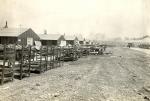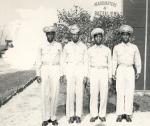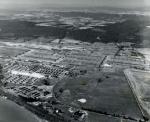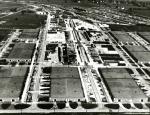![header=[Marker Text] body=[Site of a 3300-acre U. S. Army facility, 1942-45. Originally the Shenango Personnel Replacement Depot; renamed 1943. During World War II about a million troops passed through here; most were headed for Europe. A peak of 75,000 were housed here at one time; racial unrest flared up, July 1943. Here also were over 1800 German prisoners of war, 1944-46. After 1946 this became a scene of major civilian development. ] sign](http://explorepahistory.com/kora/files/1/10/1-A-2EE-139-ExplorePAHistory-a0k4x7-a_450.jpg)
Mouse over for marker text
Name:
Camp Reynolds
Region:
Lake Erie Region
County:
Mercer
Marker Location:
Rte. 18 S of Greenville (MISSING)
Dedication Date:
September 1994
Behind the Marker
Camp Reynolds typifies the frenzied development that took place all across the United States during World War II. The simultaneous development of the American military forces and the economic support needed to sustain the nation's war effort saw a rapid increase of physical plants and sites in Pennsylvania. Camp Reynolds, three miles south of Greenville, in Mercer County, also illustrates the pervading military presence on the Pennsylvania homefront. Originally named the Shenango Personnel Replacement Depot, the base was renamed to honor Union General  John F. Reynolds of Civil War fame.
John F. Reynolds of Civil War fame.
Needing a central camp for replacement soldiers heading for Europe, the federal government chose the site because of the proximity of two major railroads, and purchased thirty-five farms totaling more than 3,300 acres. An army of civilian workers then descended on the site and began erecting wooden barracks, headquarters, hospitals, warehouses, and other related structures. Designed to last only three years, the buildings housed more than a million soldiers en route to East Coast ports; most troops were at the camp for a week or less.
Camp Reynolds opened in late 1942 and was phased out in December 1944, when its services were transferred to Fort Indiantown Gap, near Harrisburg. The site remained in use as a prisoner of war camp, housing roughly 1,800 Germans, who were eventually repatriated. After the camp closed in January 1946, the site became an industrial park and the town of Reynolds.
Fort Indiantown Gap, near Harrisburg. The site remained in use as a prisoner of war camp, housing roughly 1,800 Germans, who were eventually repatriated. After the camp closed in January 1946, the site became an industrial park and the town of Reynolds.
When war erupted in late 1941, Pennsylvania was already home to several important military bases. In Philadelphia, the Frankford Arsenal had been an important research and development site ever since its founding back in 1816. In addition to studying captured enemy weapons, specialists at the Arsenal worked on improving small arms ammunition and trained thousands of optical workers to produce specialized optical instruments for military use.
The massive Philadelphia Navy Yard employed 70,000 workers, who built fifty new warships and fitted out 480 other vessels, in addition to refitting ships from seven allied nations. The army's Quartermaster Depot (the old Schuylkill Arsenal) was the central procurement agency for uniforms, flags, medals, band instruments, and other such items.
Schuylkill Arsenal) was the central procurement agency for uniforms, flags, medals, band instruments, and other such items.
The Signal Corps maintained its central depot in Philadelphia, and the Navy had one of its two supply depots in the city. In nearby Bucks County, the Navy built aircraft at the Johnsville plant of the Brewster Aeronautical Corporation.
Johnsville plant of the Brewster Aeronautical Corporation.
In Chester, the Army subcontracted with Ford Motor Corporation to establish the Chester Tank Depot, the largest of three such facilities in the country, to upgrade tanks to new design modifications.
Another cluster of military bases could be found in the Harrisburg area. Out in Carlisle was the Army Medical Field Service School, located in the Carlisle Barracks, here future army medics learned how to save lives on battlefields around the world. Mechanicsburg hosted the Naval Supply Depot, an 854-acre complex opened in late 1942 that specialized in every type of marine engine needed by the Navy. Closer to Harrisburg, the New Cumberland Army Services Depot, located there since World War I, was one of twelve centers around the country that shipped a wide variety of supplies overseas.
Carlisle Barracks, here future army medics learned how to save lives on battlefields around the world. Mechanicsburg hosted the Naval Supply Depot, an 854-acre complex opened in late 1942 that specialized in every type of marine engine needed by the Navy. Closer to Harrisburg, the New Cumberland Army Services Depot, located there since World War I, was one of twelve centers around the country that shipped a wide variety of supplies overseas.
In February 1941, the government established the New Cumberland Army Reception Center, the place to which most of the state's draftees were sent to be inducted into military service. The center contained a Special Training Unit whose job was to take those recruits who were somewhat illiterate and ensure that they received the proper education before continuing on to another base.
Across the river from New Cumberland was the Middletown Air Service Command, another World War I base, which stocked parts for combat aircraft and handled overhauls for damaged planes. In Harrisburg itself, the State Farm Show Building was transformed into the State School of Aeronautics, which trained civilians to work at Middletown and elsewhere. The Army Air Force operated a military intelligence school in the old Harrisburg Academy, while the Navy established a similar school at the Harrisburg Airport.
Just northwest of Chambersburg, the Letterkenny Ordnance Depot, established in December 1941, soon sprawled over 21,000 acres. The depot stored bombs and shells in igloo-shaped structures, receiving them from producers across the country and sending them out to ports for shipment overseas. The Army also established a transfer depot at Marietta, in Lancaster County, to quickly move supplies to ports as needed.
During the course of the war, the Army also opened two new hospitals in Pennsylvania to take care of wounded and sick soldiers. In Butler, the Army converted an unused state-owned tuberculosis hospital into the Deshone Army Hospital. By war's end, the Valley Forge General Hospital had more than 100 buildings, which sprawled over 183 acres. Today, both facilities are part of the Veterans Administration.
Needing a central camp for replacement soldiers heading for Europe, the federal government chose the site because of the proximity of two major railroads, and purchased thirty-five farms totaling more than 3,300 acres. An army of civilian workers then descended on the site and began erecting wooden barracks, headquarters, hospitals, warehouses, and other related structures. Designed to last only three years, the buildings housed more than a million soldiers en route to East Coast ports; most troops were at the camp for a week or less.
Camp Reynolds opened in late 1942 and was phased out in December 1944, when its services were transferred to
When war erupted in late 1941, Pennsylvania was already home to several important military bases. In Philadelphia, the Frankford Arsenal had been an important research and development site ever since its founding back in 1816. In addition to studying captured enemy weapons, specialists at the Arsenal worked on improving small arms ammunition and trained thousands of optical workers to produce specialized optical instruments for military use.
The massive Philadelphia Navy Yard employed 70,000 workers, who built fifty new warships and fitted out 480 other vessels, in addition to refitting ships from seven allied nations. The army's Quartermaster Depot (the old
The Signal Corps maintained its central depot in Philadelphia, and the Navy had one of its two supply depots in the city. In nearby Bucks County, the Navy built aircraft at the
In Chester, the Army subcontracted with Ford Motor Corporation to establish the Chester Tank Depot, the largest of three such facilities in the country, to upgrade tanks to new design modifications.
Another cluster of military bases could be found in the Harrisburg area. Out in Carlisle was the Army Medical Field Service School, located in the
In February 1941, the government established the New Cumberland Army Reception Center, the place to which most of the state's draftees were sent to be inducted into military service. The center contained a Special Training Unit whose job was to take those recruits who were somewhat illiterate and ensure that they received the proper education before continuing on to another base.
Across the river from New Cumberland was the Middletown Air Service Command, another World War I base, which stocked parts for combat aircraft and handled overhauls for damaged planes. In Harrisburg itself, the State Farm Show Building was transformed into the State School of Aeronautics, which trained civilians to work at Middletown and elsewhere. The Army Air Force operated a military intelligence school in the old Harrisburg Academy, while the Navy established a similar school at the Harrisburg Airport.
Just northwest of Chambersburg, the Letterkenny Ordnance Depot, established in December 1941, soon sprawled over 21,000 acres. The depot stored bombs and shells in igloo-shaped structures, receiving them from producers across the country and sending them out to ports for shipment overseas. The Army also established a transfer depot at Marietta, in Lancaster County, to quickly move supplies to ports as needed.
During the course of the war, the Army also opened two new hospitals in Pennsylvania to take care of wounded and sick soldiers. In Butler, the Army converted an unused state-owned tuberculosis hospital into the Deshone Army Hospital. By war's end, the Valley Forge General Hospital had more than 100 buildings, which sprawled over 183 acres. Today, both facilities are part of the Veterans Administration.









